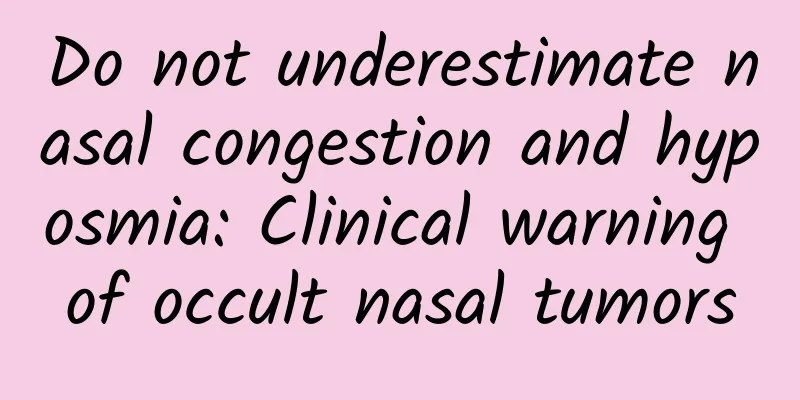Do not underestimate nasal congestion and hyposmia: Clinical warning of occult nasal tumors

|
Author: Tian Shiyu, attending physician, Beijing Friendship Hospital, Capital Medical University Reviewer: Liu Yuhe, Chief Physician, Beijing Friendship Hospital, Capital Medical University As an important organ of the human body, the nose is anatomically divided into the external nose, nasal cavity and paranasal sinuses, and plays an important role in both appearance and function. In terms of appearance, some people have a slender nose bridge and very elegant nose wings, just like an ancient Greek sculpture; some people have an upright nose bridge, like a knife carving, giving people a sense of perseverance. Functionally, it plays a key role in breathing, smell, filtration barrier and vocal resonance. In addition, it also plays a role in nerve reflex, glandular secretion, immune regulation and other functions. As an important portal, if the nasal cavity has a persistent sense of obstruction or symptoms of hyposmia, it will seriously affect the normal respiratory function of the human body and the perception of odors, and the patient's quality of life will be seriously reduced. There are many causes of nasal congestion and hyposmia, such as nasal inflammation, viral infection, nerve damage, benign and malignant tumors, etc. Among them, there is a nasal disease that is easily overlooked in clinical practice, which is nasal hamartoma, which needs to attract everyone's attention! 1. What is nasal hamartoma? Nasal hamartoma is a benign developmental lesion caused by abnormal proliferation, incorrect combination and arrangement of normal tissues in the nasal cavity. The disordered changes in the number, structure or maturity of these organ tissues will grow slowly along with the development of the human body. Figure 1 Original copyright image, no permission to reprint 2. What are the common types of nasal hamartomas? 1. Adenomatous hamartoma of respiratory epithelium: It is the most common type of hamartoma in the head and neck, characterized by excessive proliferation of respiratory epithelium and glands. It is more common in adult males, mainly in the middle-aged and elderly, and is showing a trend of getting younger. It mainly occurs in the nasal septum mucosa in the olfactory cleft area, often showing a light red, slightly tough tumor with more sticky secretions attached to its surface, which may be related to the proliferation of more glands in the tumor tissue. The root of the tumor is often wider. As the tumor continues to grow, the range of the olfactory cleft area becomes larger, which is not only easy to cause nasal congestion and obstructive olfactory hyposmia, but also compresses the surrounding bones, causing a significant widening of the olfactory cleft area. 2. Seromycinous hamartoma: It is formed by abnormal proliferation of seromycin glands, mostly located in the nasal septum or nasopharynx. Thickening of the basement membrane can be seen in the stroma, and immunohistochemical examination shows CK7 and S100 positivity. 3. Nasal cartilaginous mesenchymal hamartoma: contains cartilaginous nodules and myxoid stroma, may be related to DICER1 gene mutation, often occurs in the nasal cavity or paranasal sinuses of children, and may be accompanied by skull base invasion. 3. Why does nasal hamartoma occur? Current studies have shown that the occurrence of nasal hamartoma is mainly related to the following aspects: 1. Chronic inflammatory stimulation: Long-term inflammation leads to repeated damage and repair of the nasal mucosa, which can induce abnormal proliferation of nasal glandular tissue. As the most common type, adenomatous hamartoma of the nasal respiratory epithelium can present isolated growth, but a considerable proportion of patients also have inflammatory diseases such as chronic sinusitis, nasal polyps, allergic rhinitis, and benign and malignant tumors such as inverted papilloma and malignant tumors. Studies have shown that about 50% of its patients have a history of sinusitis or nasal polyps, and the course of the disease lasts for a long time. 2. Abnormal anatomical structure: Nasal stenosis caused by deviated nasal septum, chronic hypertrophic rhinitis, congenital abnormalities in the development of nasal and sinus structures, and structural abnormalities caused by nasal and sinus surgery can increase the risk of local inflammation and abnormal proliferation of glandular tissue. Studies have shown that patients with a surgical history of more than 10 years have a higher incidence of nasal hamartomas. 3. Immune-related mechanisms: Clinically, some patients suffer from allergic rhinitis and asthma, which may be related to the release of cytokines in the local immune microenvironment of the nasal cavity, promoting glandular tissue proliferation and basement membrane thickening, suggesting that the immune system may be involved in the occurrence and development of the disease. 4. Genetics and gene abnormalities: Current studies have found that there are allele deletions in adenomatous hamartomas of the nasal respiratory epithelium, and the deletion ratio is close to that of some low-grade adenocarcinomas; nasal cartilaginous mesenchymal hamartomas are associated with DICER1 gene mutations. 5. Environmental stimulation: Long-term exposure to chemical substances (such as formaldehyde) or air pollutants will aggravate the damage to the nasal mucosa and promote the abnormal proliferation of nasal tissues, which is also an important cause of nasal hamartoma. 4. What are the common symptoms of nasal hamartoma? 1. Persistent nasal congestion This is one of the most common symptoms. Patients may experience unilateral or bilateral nasal congestion. As the tumor grows, the symptoms gradually worsen and do not respond well to conventional drug treatments (such as nasal spray hormones). 2. Olfactory impairment About 50% of patients have tumors originating from the olfactory cleft (the area where the olfactory nerves are distributed), and mechanical obstruction leads to a decrease in or complete loss of olfactory perception, causing hyposmia or loss of smell. 3. Runny nose, swelling and pain in the head and face Patients often have thick nasal discharge or a swollen and painful sensation in the head and face. This is mainly because the tumor causes secondary rhinitis, sinusitis and nasal polyps, which aggravates the inflammatory response and increases the secretion of mucus in local tissues. Figure 2 Original copyright image, no permission to reprint 5. What harm can nasal hamartoma bring to us? Although nasal hamartoma is a benign tumor, it may cause many harms to patients if it is not diagnosed and treated in time. 1. Impaired respiratory function The space-occupying growth of nasal hamartomas can cause nasal congestion in patients, which gradually worsens. Long-term nasal congestion not only affects the patient's normal respiratory function, but may also lead to chronic hypoxia due to poor breathing during sleep. In the long run, not only will symptoms such as fatigue, decreased concentration, and sleep disorders occur, but it may also cause disorders in the cardiovascular and endocrine systems, greatly increasing the risk of systemic diseases such as hypertension, coronary heart disease, and diabetes. 2. Decreased sense of smell Nasal hamartomas often occur in the olfactory fissure area of the nasal cavity. Due to blockage or compression by the tumor, the conduction function of the olfactory nerve is damaged. In severe cases, the olfactory nerve undergoes degeneration, and it is difficult for the sense of smell to fully recover, which seriously affects the patient's daily quality of life. 3. Local compression and structural damage Although nasal hamartoma is a benign lesion, the tumor may compress the surrounding tissues and structures of the nasal cavity, leading to corresponding clinical symptoms. For example, involvement of the nasolacrimal duct may cause repeated epiphora, and outward growth of the tumor may cause nasal dorsum or facial protrusion affecting appearance. If allowed to develop, the tumor may extend from the nasal cavity into the skull, which not only increases the risk of intracranial infection and intracranial hypertension, but also increases the difficulty of surgery. 4. Risk of sinus infection If nasal hamartoma blocks the sinus opening, it may cause secondary diseases such as chronic sinusitis and nasal polyps, aggravate local inflammatory response, and multiple diseases will affect each other to form a vicious circle, jointly promote the development of the disease, and further reduce the patient's quality of life. 5. Risk of bleeding The mucosal blood vessels on the surface of nasal hamartomas are rich and can easily rupture due to friction or inflammation, leading to repeated nasal bleeding or blood in mucus. In summary, nasal hamartoma is a disease that is underestimated and easily neglected in clinical practice. It is very important to correctly understand and treat this disease. This article hopes to help everyone better understand nasal hamartoma and deepen and improve their understanding. When symptoms such as nasal congestion and loss of smell occur, especially when drug treatment is ineffective, you need to seek medical attention in time. If necessary, perform nasal endoscopy and sinus CT examination to prevent missed diagnosis and delay the best treatment time! |
>>: Understand chronic sinusitis and win the battle to protect your nasal cavity!
Recommend
What to do if you are pregnant with rheumatoid arthritis
Rheumatoid disease is hereditary. If parents suff...
Will I still have my period in the first month of pregnancy?
Menstruation occurs every month when a woman is n...
The best time to have an abortion
Every couple has their own considerations on the ...
Is bleeding after artificial insemination normal?
Artificial insemination is a common means of assi...
Will ovulation occur on the last day of menstruation?
We know that menstruation is a normal physical co...
Why do I have breast pain before my period?
Many women experience breast pain before each men...
GSMA&VitalWave: Survey shows Chinese women are more interested in mobile Internet
There are 950 million working women living in dev...
How long should I wear a belly band after a cesarean section?
After a woman becomes pregnant, her abdomen will ...
Several secrets to keep women's private parts tight
Many female friends use private cleaning products...
What causes a girl to smell down there?
The common cause of odor in women's private p...
Can I take vitamin C when I am preparing for pregnancy?
The arrival of a baby can make a family more perf...
Can I have a child if I have vaginitis?
If the symptoms of vaginitis are relatively mild,...
Did you know that some people are more susceptible to cancer than others?
This article was reviewed by Dr. Guo Xiaoqiang, a...
How can women replenish their kidneys the best and fastest?
Many people think that men need to nourish the ki...









